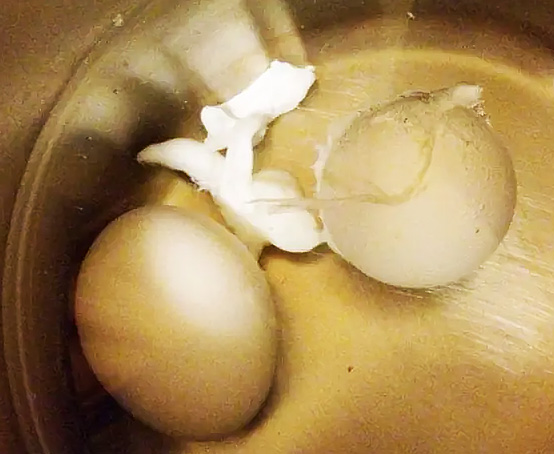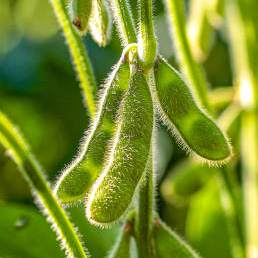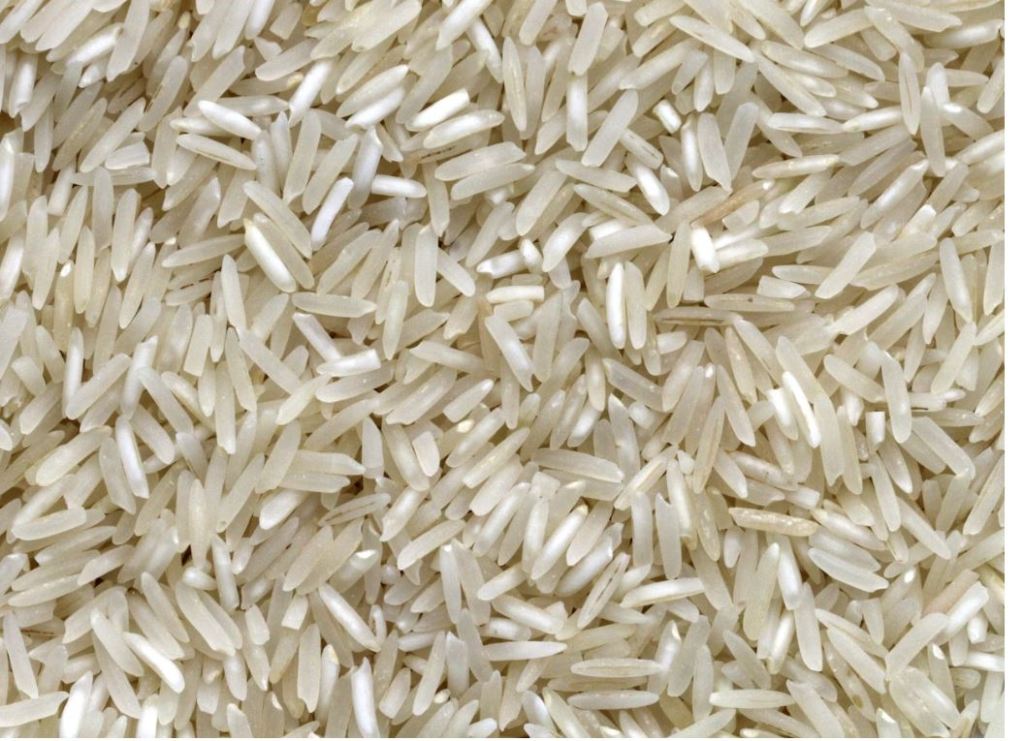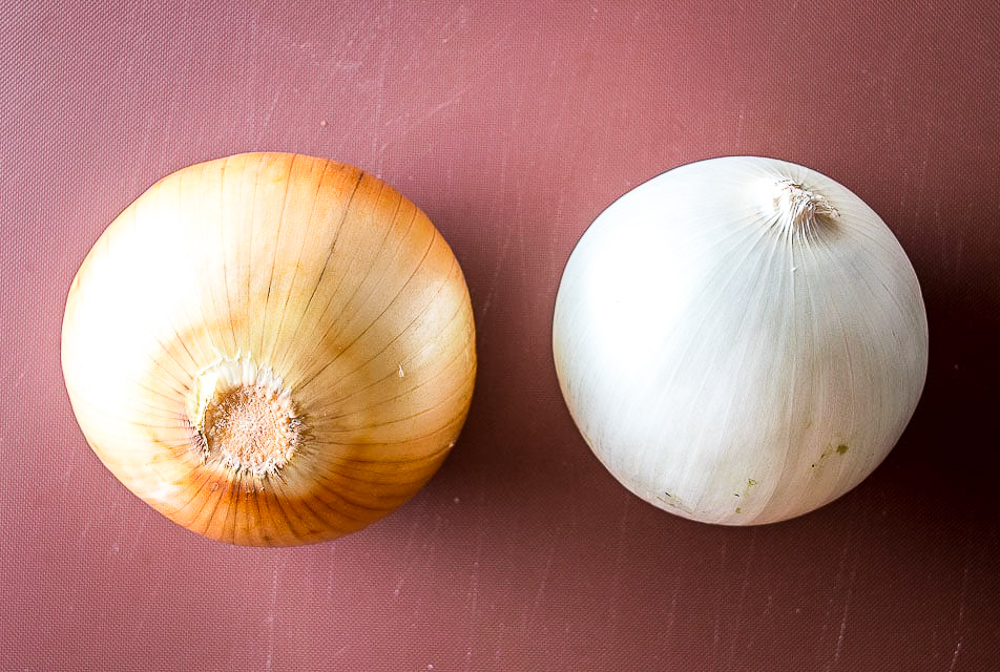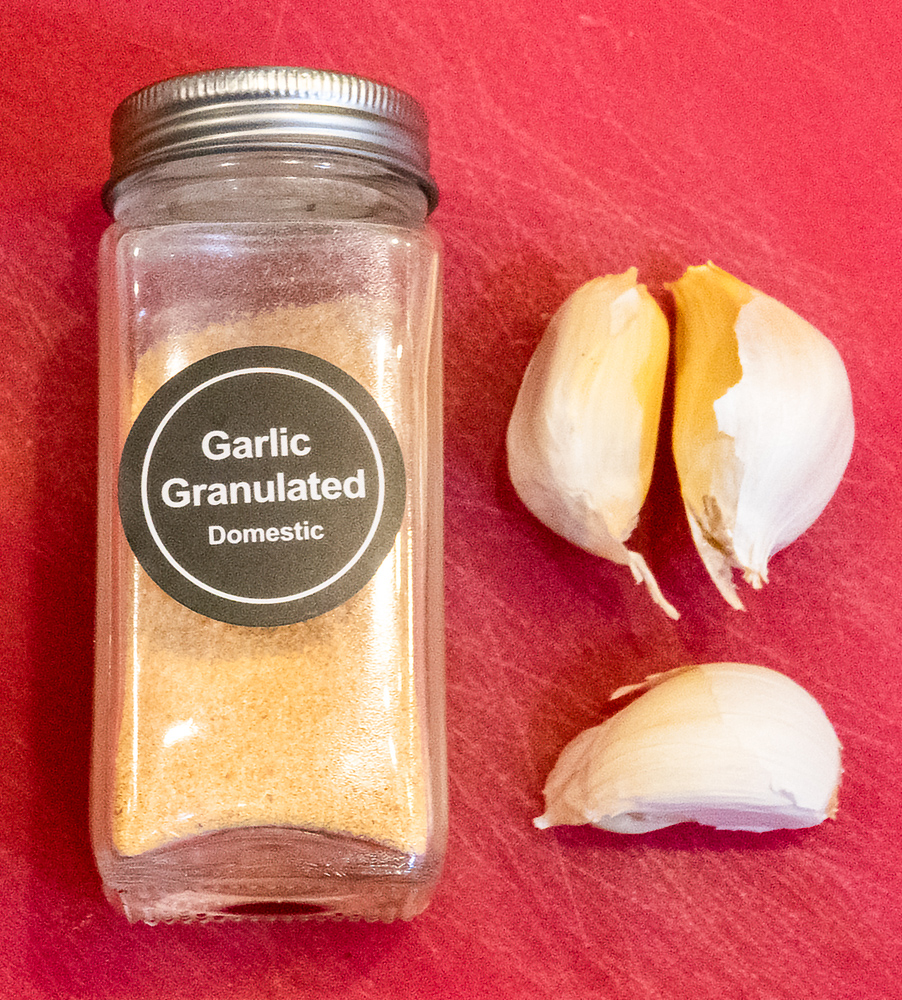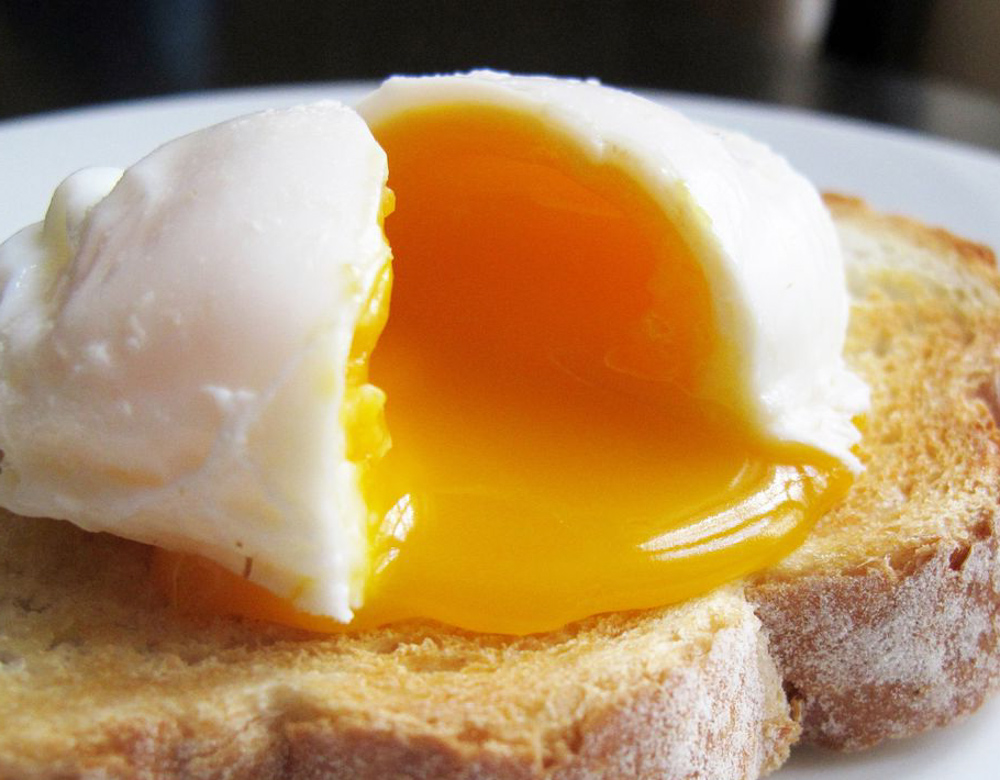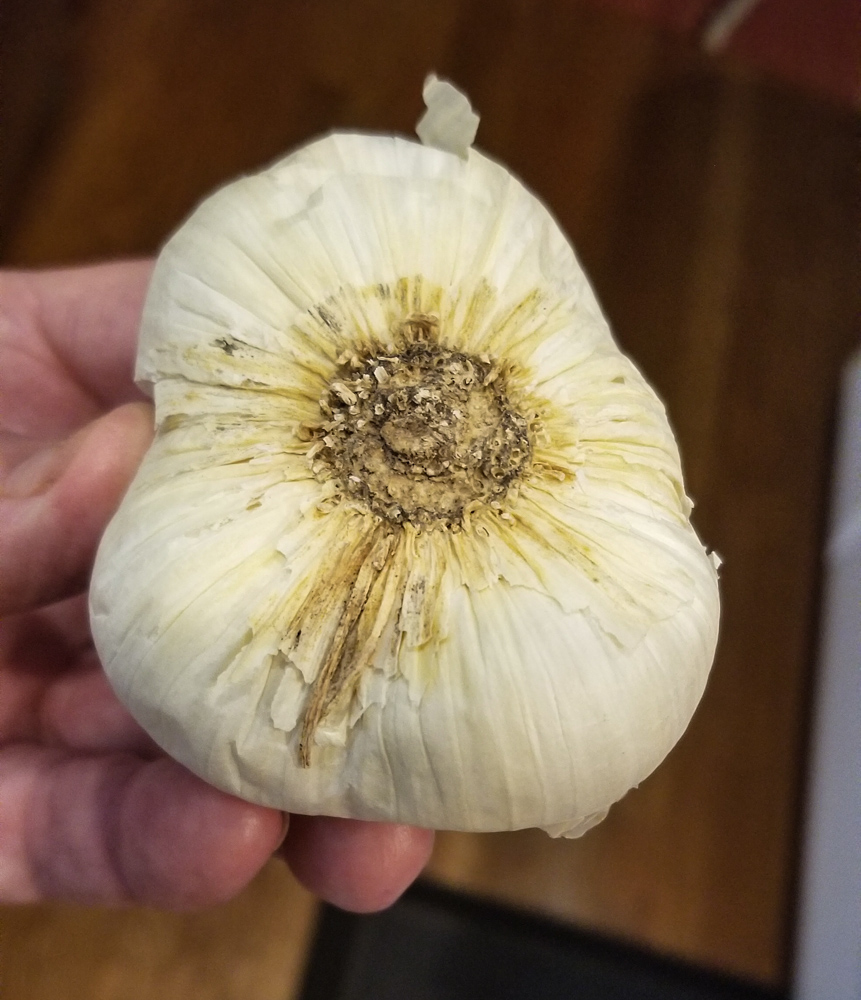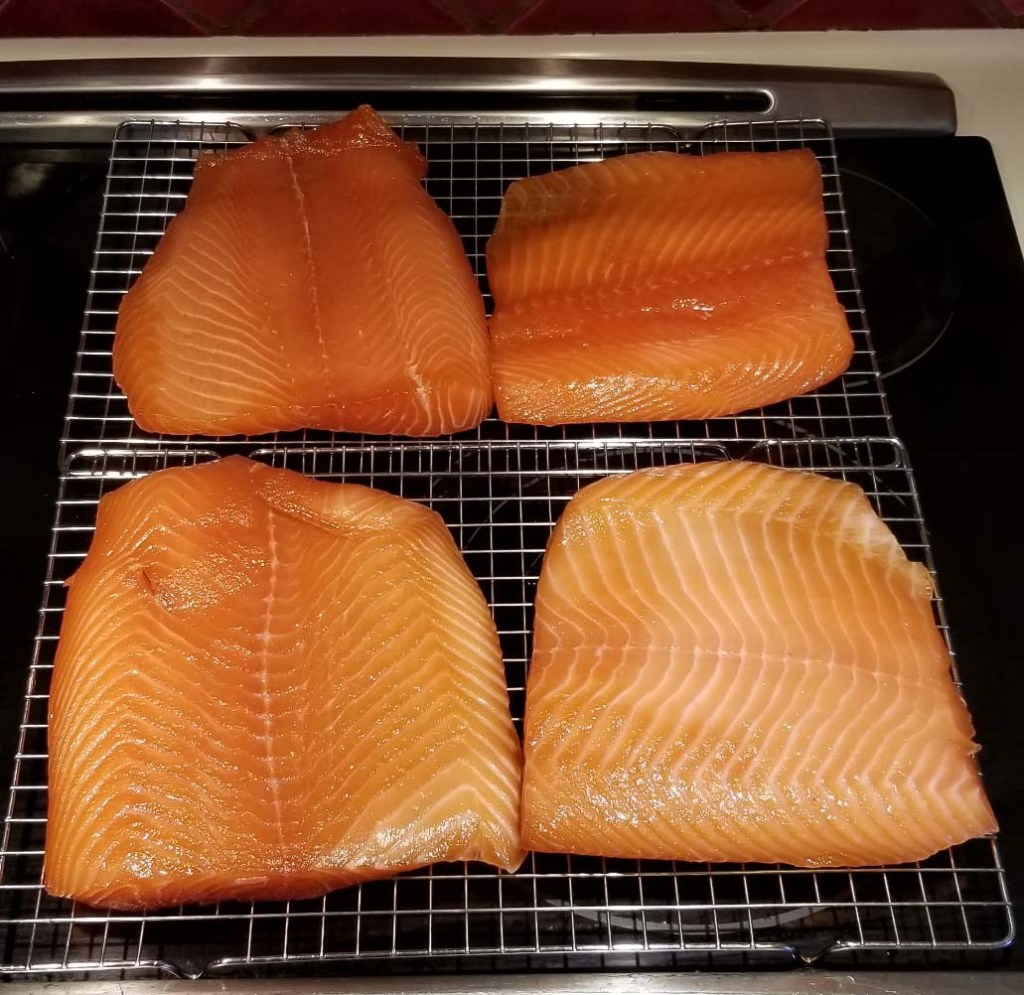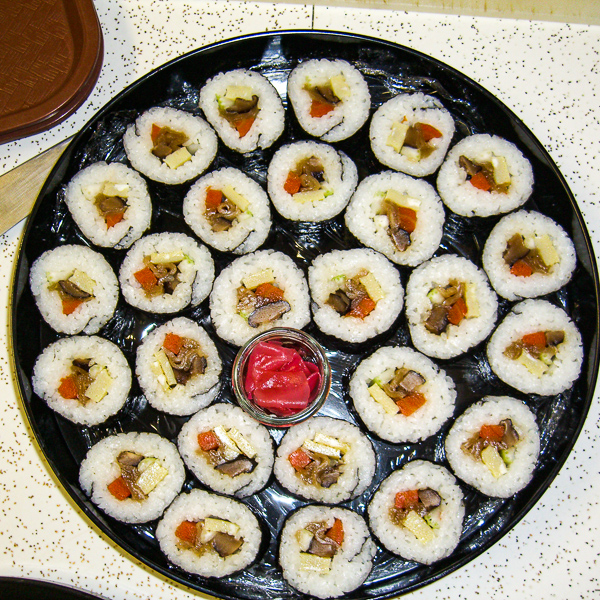Kitchen Myths
Facts and fiction about food and cooking
Category Archives: Ingredients
When sautéing mushrooms, add salt at the beginning of cooking.
Many cooks like to sauté mushrooms, usually in a bit of butter or oil, until they are a bit brown. This improves the flavor and texture. And most people add the salt (if they are using it) right at the start of cooking. not a good idea! Adding salt at the end gives better results. Why? Adding salt at the start can draw liquid out of the ‘shrooms which will inhibit browning. So, add that NaCl right at the end of cooking. You’ll thank me!
Cold egg/hot water is why boiled eggs crack
Many people hard-cook eggs by putting them in already-boiling water. The temperature shock, it is claimed, causes the shell to expand quickly and crack, with stringy egg white leaking out. But while this seems to make sense, it is not true.
First of all, an expanding shell in not likely to crack–a shrinking shell is. In this case, an egg might crack when it is done cooking and is transferred from the boiling water to the cold. Of course, by this time, cracks do not matter.
iI one saw Julia Child, on her show, demonstrate this. She took a bunch of raw eggs from an ice water bath directly into boiling water, and not one of them cracked. Pretty convincing!
So, why do some eggs crack? It seems to be two things. Some eggs already have invisible cracks in them from rough handling during production and shipping. These will indeed open up in hot water and release egg white. Also, rapidly boiling water will bounce the eggs around and cause new cracks. Thus, if you must boil eggs, use gently simmering water.
But the best way to cook “hard-boiled” eggs is, in my and many other cooks’ opinions, steaming. Please refer to this post.
Eating soy products can increase breast cancer risk.
Soy contains compounds called isoflavones, which mimic some effects of estrogen. Isoflavones were found to stimulate the growth of breast cancer cells in animals, hence the origins of this myth.
But there is no similar effect in humans, and in fact soy products may actually have protective effects regarding breast cancer. Plus, they are excellent sources of certain nutrients including protein and minerals. So, you can munch tofu, tempeh, miso etc. without concern.
You cannot get complete protein from a vegetarian/vegan diet
It is believed by many that only animal-based foods contain all nine essential amino acids–the amino acids that humans cannot synthesize and must be obtained in the diet.
Amino acids are the building blocks of proteins and having all of them is essential to good health. But the fact is that all nine essentials are found in plants, just not all of them together in one food. So, eating a varied diet of plants – nuts, grains, beans, and so on – will give you all you need.
Rinse rice to remove arsenic
It’s unfortunately true that rice contains more inorganic arsenic (the toxic stuff) than other grains. This is simply in the nature of rice, to concentrate whatever little bits of arsenic are present in the soil and water. But the arsenic is in the rice, not on the surface, so rinsing will do no good.
It is still a good idea to rinse rice in most situations to remove excess surface starch, which will make the cooked rice gummy.
White and yellow onions are interchangeable
For a long time, I thought that the white and yellow onions I saw in the market were essentially the same except for the skin and flesh color. But no, there are real differences. For long-cooked dishes such as stews these differences don’t matter but in other applications they might.
White onions are a bit milder and less pungent than the yellow. They are also a bit more expensive, usually. This means the white are preferred for use raw or when quickly cooked–think potato salad, sandwiches, stir fries, and so on. The yellow may provide a bit more flavor in long-cooked dishes such as stews and soups.
These are minor differences, to be sure, and with the wide availability of “sweet” onions such as Vidalia it is less important. But there you have it!
Flip a steak only once during cooking
It is an article of faith among many steak lovers that a steak should be flipped only once, whether being cooked on the grill or in a pan. Turns out that this is a myth. Single flipping certainly won’t ruin anything, but multiple flips–say every 30 seconds– results in more evenly cooked meat with less overcooked meat at the edges. Try it yourself, you’ll see!
Canned pumpkin is not real pumpkin
I believed this for years–that the canned pumpkin puree sold for making pies and the like actually comes from a kind of squash. But in reality, about 90% of canned pumpkin is real pumpkin. Not the bright orange jack-o-lantern kind of pumpkin, which has been bred for looks and not flavor. Rather, the Dickinson pumpkin is typically used due to its being meatier and tastier.
Squash is indeed sometimes used but there’s no need to turn your nose up. It can be just as tasty as “real” pumpkin and some people actually prefer it.
Fresh herbs are always better than dried
Most chefs prefer their herbs to be fresh, and the fact is you cannot go wrong this way. But for some herbs, dried can be just as good for cooking. The difference is in the nature of the flavor compounds. For some, the flavor compounds are volatile and are removed by the drying process. Basil is an example and adding dried basil to a dish provides no flavor, just green flecks! Other herbs, typically those that grow in hot, dry climates, have flavor compounds that survive drying and work just fine in cooked dishes (as well as being cheaper and more convenient). Here’s a guide:
Best used fresh:
- Basil
- Chervil
- Chives
- Cilantro
- Dill
- Mint
- Parsley
- Sorrel
- Tarragon
OK to use dried (in cooking):
- Bay leaf
- Marjoram
- Oregano
- Rosemary
- Sage
- Savory
- Thyme
Garlic powder is a good sub for the fresh stuff
Garlic powder–or its kissing cousin granulated garlic–is sure convenient. Lasts forever in the pantry, no peeling or smelly fingers. There’s just one problem though: it does not taste like garlic! Seriously folks, the chemicals that give fresh garlic its unique flavor are destroyed or removed by the drying process.
This does not mean garlic powder is useless. It has its own flavor that I find good in BBQ rubs. And peeling can be avoided if you buy pre-peeled whole raw cloves. They must be refrigerated and do not last as long as whole dried heads, but the flavor is fine.
And avoid garlic juice, paste, and pre-minced garlic. The unique garlic flavor is created via a chemical reaction that occurs when the clove is cut or mashed, and this flavor starts dissipating immediately.
Poach eggs in water with vinegar for a better shape
Eggs set up when their proteins denature, typically when exposed to heat. But acids–such as vinegar–also can cause egg whites to denature. Thus, some people add vinegar to the poaching liquid on the theory that it will give eggs with a nicer shape.
Nice theory, but it doesn’t work. The problem is that acid denatures egg proteins slowly, and by the time the vinegar has an effect the eggs are already set up from the heat. And the vinegar can make the eggs a bit tougher and, of course, add a vinegar taste. So, skip the vinegar!
What about salt? It has no effect on the cooking but can help the flavor.
For best results, salt scrambled eggs at the end of cooking
My usual technique was to beat the eggs with salt (and maybe a touch of milk) and cook them immediately. The other day I got distracted and the salted, beaten eggs sat for about 30 minutes before they went in the pan. They were unusually good! So I did some research and turns out I was not imagining it.
When eggs beaten with salt sit for a while, the salt causes some physical changes. You can see this in their color–after sitting, the salted eggs take on a deeper, richer yellow color. It also leads to particularly moist and tender curds when cooked. Beating in the salt just before cooking gives fine results too, just not quite as fine! And adding salt near the end of cooking gives tougher curds that may be watery. So, salt early when you can!
All domestic garlic has roots
While a lot of garlic is grown here in the US, some is imported from China and other countries. If you want to buy American, believe the rumors that Chinese garlic is toxic, or simply believe that domestic garlic tastes better, how do you tell the difference? It’s been said that all Chinese garlic has no roots because they have been cut off to meet import requirements (see first photo), while domestic garlic always has roots (which may have been trimmed short, see second photo). Well, no.
For one thing, all imported garlic has trimmed roots, so it may be from Canada or Mexico and not necessarily from big bad China. But more important, plenty of domestic garlic also has trimmed roots, so it’s not a reliable way to tell. Bottom line? Roots = domestic, no roots = who knows?
High heat destroys allergens
An allergen is a chemical in food that causes the allergic reaction. Food allergies an be deadly, as with a peanut allergy, which can kill you dead, or mild, as with my father-in-law who would get dry eyes after eating a banana.
It’s a mistake to think that allergens can be destroyed by cooking, even at high heat such as deep frying or grilling. For example, French fries may see fine for someone with a peanut allergy, but not if they are fried in peanut oil. It’s true that cooking works sometime. For example, people with dairy allergies may be able to eat cooked items, such as a cake, that contain milk. So don’t count on cooking to save the day!
“Refried beans” means beans fried twice
This is a common error because, in English, the prefix “re” means “again.” The Spanish name for this dish is frijoles refritos, and refritos means “well fried” (frijoles = “beans”)–so what we really have is well-fried beans. And of course the basis of this dish is frying and mashing cooked beans with flavorings, so there you go. Here’s a recipe for homemade.
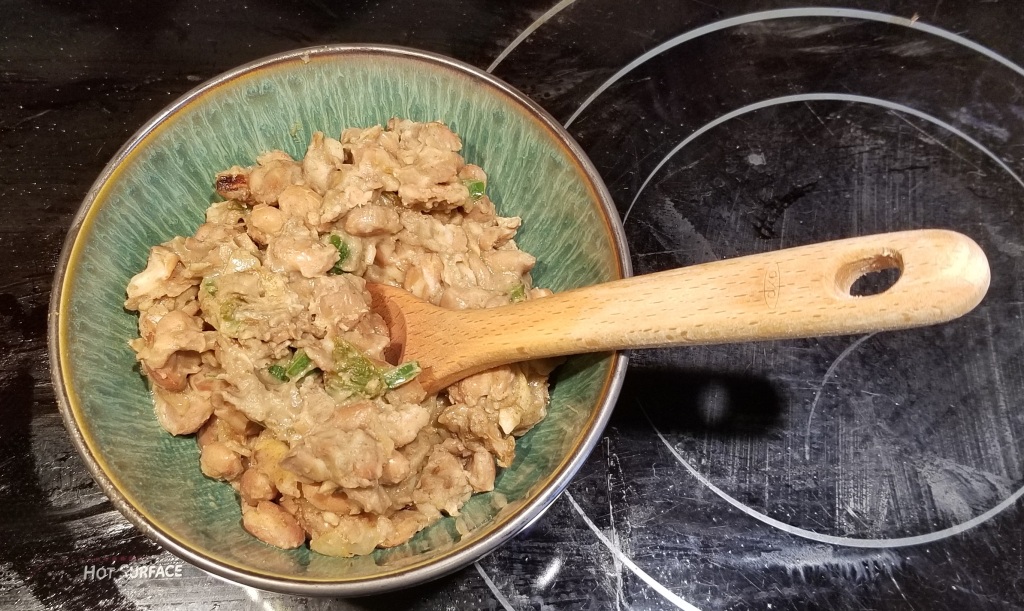
White chocolate is real chocolate
No, and I do not know why it is even called chocolate because it tastes nothing like it. Well, actually I do know–it is marketing, because everyone likes chocolate, right?
White chocolate is made from cocoa butter, the fat/oil that is pressed out of cacao beans during processing. Sugar and vanilla flavor are added. Cocoa butter has no chocolate flavor–that’s left behind in the cocoa solids that are made into cocoa powder and then into (real) chocolate candy, etc. Cocoa butter is extensively used in skin care products, for what it’s worth. But it is not chocolate, despite the deceptive name.
Lox means smoked salmon
Bagels and lox, lox and bagels–and lox means smoked salmon, right? Wrong! I thought this was true for many years, and indeed it is common usage. Buy nay, this is not what lox means.
Lox starts with salmon fillets. They are covered with a good amount of salt (always), sugar (usually), and spices/herbs (optionally). This mixture is called the cure. They sit for a while, at least overnight and usually longer. Then the cure is rinsed off and, voila, you have lox (sometimes called gravlax). The curing process will have drawn a lot of water out of the fish, making it a lot firmer, and imbued it with salt and other flavors. Yes it’s raw, but the cure has killed any nasties. It’s yummy enough now.
But then, you can smoke it. This is cold smoking where the fish is exposed to smoke but not heat. After quite a few hours in the smoke, the lox has absorbed the smoke flavor and is, at least in my opinion, even more delicious. It’s a light smoke, usually done with fruit wood, nothing like what would be done for BBQ or ribs (hickory or mesquite). The salmon is now known as Nova. The name Nova is capitalized because it comes from the name of Nova Scotia, the Canadian province where a lot of the salmon is–or at least was–caught.
Now of course a lot of people refer to Nova as lox so the meanings may be changing, as word meanings tend to do. But now if someone offers you Nova you’ll know what they mean.
And then there is hot smoked salmon, smoked and cooked at the same time. Delicious stuff, but very different from lox and Nova.
Coconut oil is good for your health
This is one of those malarkey marketing scams that so many people fall for all the time. Coconut oil as the new super food, with claims that it lowers blood pressure, promotes weight loss, reduces blood glucose, protects against heart disease, erases wrinkles, increases energy, reduces inflammation, and counters Alzheimer’s disease. Nope to all these claims–y’know, that little pesky matter of evidence, of which there is none. That doesn’t stop some people, to the supplement makers’ delight.
Coconut oil does have a unique taste that some people love, and using it in your diet occasionally is not a problem. But don’t expect any health benefits. And, by the way, external use is fine.
Molasses and black strap molasses are interchangeable
No way. They have the same origin–sugar cane–but are quite different. In a nutshell, the liquid squeezed from the sugar cane is boiled until most of the sugar crystallizes. The sugar is separated and further processed to become the granulated sugar we are all familiar with. The liquid remaining is molasses. It is sweet, slightly bitter, and with a complex flavor that is important in many baked goods.
If you take molasses and boil it down even more, you get black strap. You might think it would just be a more concentrated molasses, but no–the additional cooking breaks down a lot of the sugar into simpler molecules and the result is less sweet and much more bitter than real molasses. It’s quite salty, too.
Bottom line, molasses and black strap molasses are two quite different critters and cannot be interchanged.
Miracle Whip is mayonnaise
Some folks confuse the two as they are both white condiments that are often spread on sandwiches. But they are quite different.
Nope. Mayonnaise is an emulsion of fat and oil, with the fat being egg yolks, along with an acid such as vinegar or lemon juice. Salt is added and often other seasonings. By law, mayonnaise must be 65% oil by weight and the emulsifier must be egg. It’s easy to make at home, but most people rely on the commercial product (don’t get me started on Hellman’s vs. Duke’s!).
Miracle whip, on the other hand, is classified as a salad dressing. The main three ingredients are water (yes, water), soybean oil, and high-fructose corn syrup. Eggs are further down the list. It was developed as a less expensive alternative to mayo and has become very popular. But mayo it is not.
All wild rice is the same
Wild rice is a delightfully tasty grain that has many culinary uses. Its slightly chewy texture and nutty flavor make it a good match in many situations. It’s sort of pricey, though, and many people have never even heard of it. But if you want to give it a try, be aware that all “wild rice” is not the same.
True wild rice grows in shallow lakes and slow-moving streams in the north-central part of the US (Minnesota, Wisconsin, Michigan) and adjacent areas of Canada. It has been a staple food of Native Americans for ages. It is hand-harvested and parched (to remove the husk) using wood fires. It is a medium brown color and is the more desirable (and expensive) kind of wild rice.
The other kind is not wild rice at all, really, as it is cultivated in paddies. Also, it is a genetic hybrid developed specifically for cultivation. It is machine-harvested and dried using artificial heat. It is very dark brown or almost black in color. Compared with the real stuff, it’s a bit chewier, less flavorful, and less expensive.
Both kinds of wild rice can be very tasty and used with great success in many dishes. Just be aware of the differences and shop accordingly.
Gluten-sensitive people must avoid MSG
Monosodium glutamate, or MSG, is a popular flavor enhancer that has gotten an essentially undeserved bad rap on the health front (see here). One more twist to this is the truly bizarre idea that MSG is somehow related to gluten, the protein found in wheat and some other grains that causes nasty reactions in celiacs and others with a gluten sensitivity. Nope, the two are completely unrelated. A food may contain both gluten and MSG, of course, but that’s a different matter.
It’s unsafe to eat raw oysters in months without an “r” (May thru August).

A lot of people still believe this but it just ain’t so. There was some validity to it long ago, before refrigeration, when oysters headed to market were more likely to spoil because of the warm weather. And back then, oysters were wild-harvested and there was a greater chance of them being contaminated with red tide or or bacteria, which flourish in warm water. With today’s regulated farming techniques, oysters are monitored for contamination. And, of course, with refrigeration they can be kept nice and cold from ocean to table.
Safety aside, however, some oyster aficionados stay away from oysters from May to August because of the taste–they claim that cold month oysters are tastier and plumper. Be that as it may, don’t let the time of year deter you if you are jonesing for oysters.
Don’t store tomatoes in the fridge
For many years I actually believed this, having read it in more than one source that I consider authoritative. The cold, it was claimed, would inhibit the formation of certain flavor compounds. But recently, a well-respected cooking show/magazine did side-by-side taste tests and could detect no difference between ‘maters that had been refrigerated and those that had not. And refrigeration can help tomatoes last longer, too. Of course not-quite ripe ones should be left out to complete the ripening.
Tellicherry peppercorns come from Tellicherry, India.
This is a commonly believed myth, yours truly included (until recently). But the truth is much more mundane. The term is actually used for the largest peppercorns; they are grown on the same plant and processed just like “regular” pepper. Apparently some people find the large corns to be more visually appealing, so they sometimes command a price premium. Taste-wise, no difference.
As an aside, the city of Tellicherry is now known as Thalassery.
For better results, let steaks rest at room temperature before cooking
Some folks think that letting a steak sit out at room temperature for 30-60 minutes before cooking leads to better results. The reasoning is that bringing a cold steak up to room temperature results in more even cooking and a better crust. It just ain’t so. For one thing, the steak warms up very little during this time. And even if you let it sit out a lot longer it does not, in tests, make any noticeable difference in the results.
So take your steak out of the fridge ahead of time if you wish–it does no harm–but if you forget, fret not.
Foods labeled “no MSG added” contain no MSG
This is legal but somewhat deceptive labeling on the part of manufacturers, likely because some people try to avoid MSG (but see below). Check the ingredients–if they include hydrolyzed soy (or vegetable) protein (HSP), then you’ve got MSG. Seems that MSG is an unavoidable byproduct of the manufacture process for HSP and in fact is the main reason that HSP is added to foods. Let’s face it, there’s no denying that MSG makes many foods taste better.
So why isn’t MSG on the label? It seems that it is not required to list things that are “ingredients of ingredients.” For example, if a product contains milk, the ingredient list does not need to say “milk proteins,” and the same for anchovies and salt.
Now onto the sidebar. Why do some people want to avoid MSG? There’s this fantastical idea that MSG is bad for one’s health, for which there is precisely zero evidence. And some claim to get “Chinese restaurant syndrome” from MSG, a phenomenon that seems to be purely psychological. You can read more here.
Tomato is a vegetable
OK, before you start rolling your eyes, I am well aware that this myth falls, for most people, in the “who cares” category. But who knows, you may find yourself on Jeopardy someday!
From a scientific standpoint, a “fruit” is the part of a plant that contains the seed(s). Thus, apples, oranges, cantaloupes, peaches, and grapes are all fruits. No surprise there! But by this definition, tomatoes, squash, eggplant, cucumbers, okra, peppers, and many other “vegetables” are fruits. True vegetables include lettuce, carrots, potatoes, cabbage, celery, ginger, garlic, asparagus, and so on.
Of course, we all use the common distinction that vegetables are not sweet and are typically eaten with the main course, while fruits are sweet and are more often eaten on their own or as part of dessert.
Don’t eat liver because it contains toxins
Many people just plain hate the taste of liver, that’s fine–although in my experience this is almost always because they have eaten overcooked liver, which is indeed awful. But others avoid liver because of the myth that the liver contains lots of toxins that have been concentrated from the blood. It just ain’t so.
The liver does in fact extract toxins from the blood, but then these toxins are converted–metabolized– to waste products and excreted from the body. They do not accumulate in the liver. So if you are like me and love liver, munch away! Just be sure to cook it properly, which means not overdone.
Sea salt is different from “regular” salt
Much is made these days about using sea salt in recipes, as if it is automatically better than regular salt, which is mined. Sorry, but this is not true. Fact is, all salt is sea salt–but some ended up underground after ancient seas dried up and the salt deposits were buried by geological processes. In contrast, sea salt is made by letting sea water evaporate in shallow ponds. So when a recipe specifies sea salt, take it with a grain of salt (sorry, couldn’t resist!) and use whatever you have on hand.
This is not to say that all salt–mined or sea–is the same. In some locations, the salt has, for various reasons, been infused with tiny amounts of other minerals that can change its color and perhaps its taste. For example, Himalayan pink salt is mined in the Himalayas and contains, according to the manufacturer, 84 additional minerals that make it a delicate pink color. Likewise, Malden sea salt, from England, is supposed to be unusually pure and comes in large, irregular flakes that give it different mouth feel.
Snowy white scallops are the best
Some fresh (not frozen) scallops you see in the store are as white as snow. Others are more of a pale tan/ivory color. Many people mistakenly think the whiteness means better quality. Actually, it is the reverse.
The snow white scallops are called “wet scallops” because they are soaked in a solution of water and sodium tripolyphosphate. This helps to preserve them and also causes them to absorb more water–and to turn pure white. As a result, the same amount of scallops will weigh more after soaking than before, and bring in more money.
The “dry” scallops are not soaked and hence keep their natural tan/ivory color.
Sugar makes kids hyperactive
This notion has been around since 1922, but numerous scientific studies have shown it to be false. The few studies that seemed to support this idea have been discredited and the evidence that it is false is rather substantial. There are still reasons to limit your child’s sugar, such as weight and diabetes, but hyperactivity isn’t one of them.
Store-bought food labeled uncured is actually uncured.
The simple fact is that you cannot make things like bacon, corned beef, lox, and ham without curing. The confusion arises because the US Government defines curing as treatment with synthetic nitrates/nitrites to inhibit bacterial growth, and that’s all. So food without those things is legally called “uncured.” But for centuries, curing has traditionally meant rubbing meat with salt, spices, and maybe sugar, or exposing it to a brine, and letting it sit for a while before cooking, and that’s still what’s done. So, in the store, “uncured” means simply “no synthetic nitrates/nitrites.”
But to complicate things, note that I specify “synthetic” nitrates/nitrites. If naturally derived nitrates/nitrites (usually from celery) are used, the meat can still be called uncured. Of course, the synthetic and natural chemicals are exactly the same, so this is just silly, but what can you do.
And if you are worried that nitrates/nitrites are bad for health, please see Avoid cured meats because of nitrates/nitrites.
Clear vanilla extract is real vanilla
Oh no, not by a long shot. Real vanilla extract is made by soaking vanilla beans in an alcohol solution until the flavor comes out, and it is unavoidably brown. The clear stuff may be made from seeds of the tonka tree, and while it may smell and taste like real vanilla it is not. And, it can contain coumarin, a blood thinner that may be dangerous for some folks. Or perhaps the clear vanilla “extract” contains synthetic vanillin which is made from paper pulp and coal tar. Best to stay with real vanilla extract, expensive as it may be.
Baby carrots are actually baby carrots
Nope, it’s just marketing. The small, torpedo-shaped carrots you see labeled as baby carrots are actually mature carrots that had some physical deformity, such as being crooked , and therefore could not be sold whole. Some marketing genius realized that these carrots could be mechanically trimmed down and the bad or ugly parts removed, with the remaining good part labeled “baby.” Now there’s nothing at all wrong with these carrots, except perhaps the inflated price–I use them all the time. Just be aware that you are not actually getting baby carrots.
“Carolina” rice is the same as “Carolina Gold” rice
In many markets you will find bags of “Carolina” rice. Don’t be fooled into thinking this is “Carolina Gold” rice. History, or perhaps legend, tells us that Carolina Gold rice came to South Carolina in 1685 when a ship traveling from Madagascar stopped in Charleston and paid for repairs with a bag of rice seeds. These seeds were the foundation of South Carolina’s 200 year history as the leading rice producer in the US. This rice’s taste and texture set it apart from other rice and it was in great demand. For various reasons, cultivation died out around the end of the 19th century. Today, a few specialty growers keep it going and sell to the public (yes, it is expensive!).
“Carolina” rice, on the other hand, is nothing more than a trademarked brand name. The rice is not the same strain as Carolina Gold and it can be grown anywhere – Texas, Arkansas, etc. It is perfectly fine rice but is not Carolina Gold and does not have the special taste and texture.
Navy beans and great northern beans are the same
They are, to tell the truth, quite similar. But not the same. In most cases it does not make any practical difference. Navy beans are smaller yet take longer to cook than great northern beans. They feature in famous recipes such as Boston baked beans and Senate bean soup. But great northern beans taste pretty much the same. So don’t worry about which kind you have as long as you are aware of the cooking time difference.
Gluten-free foods are more healthful
We have already dispelled the myth that gluten is somehow bad for your health–aside from the small percentage of people with celiac disease this is simply not true (see here). There’s another gluten-related myth, however: that gluten-free foods are somehow more healthful than their “normal” gluten-containing counterparts. In fact, over 30% of Americans surveyed say they sometimes buy gluten-free because they believe this. But it is not so. In fact, gluten-free foods are very often less healthful because they contain less protein, fiber, and vitamins and more fat! And of course they are more expensive and usually don’t taste as good.
Organic food does not contain pesticides
If only. Fact is, there are numerous toxic pesticides (insecticides, herbicides), both natural and synthetic, permitted on organic crops, with the full blessing of the organic certification agency. This includes pyrethrins, nicotine, spinosad, and copper sulfate. And some organic farmers are pressuring the FDA to allow additional pesticides. Don’t get me wrong, many nasty chemicals are indeed banned in organic farming, and that is surely a good thing for the farm workers and the environment. But don’t be deluded into thinking that organic food is pesticide-free.
Sushi requires a special kind of rice
At the heart of sushi is the rice – not raw fish as some people mistakenly believe (see my related post here). In a nutshell, medium-grained rice is cooked and, while hot, mixed with a vinegar/sugar/salt mixture. After cooling, the sushi rice is used to make the sushi.
Some unscrupulous companies have perpetuated the myth that you need a special kind of rice to make sushi, and I have seen small bags of “sushi rice” for sale at outrageous prices. Fact is, the rice use for sushi is the same medium grained rice used for many other purposes in Japanese cuisine. You do not need to pay extra for “sushi” rice. Our favorite is Kokuho Rose brand, closely followed by Nishiki. These are California-grown and are every bit as good as the much more expensive Japanese imports. They are widely available, you can even get the Nishiki through Walmart! So, don’t waste your money on overpriced rice!
On a related note, short-grained rice is not used for sushi–it’s actually medium grained that is used. Many people call it short as it is indeed shorter than many other rices, such as jasmine and basmatti. Real short grained rice is shorter still with grains that are almost round. Short grained rice is sold as sweet or sticky rice, although it is not sweet–but it is sticky!
Avoid cured meats because of nitrates/nitrites
Nitrates and nitrites have been used for centuries as part of the meat curing process (bacon, corned beef, sausages, etc.). They inhibit bacterial growth (particularly the deadly botulism bacterium), improve taste, and give the meat a nice color. But there’s been this “anti-nitrate” movement for a couple of decades now, claiming that nitrates cause cancer and all sorts of nasty stuff. They even pressured Whole Foods into not selling any nitrate-containing meats. The evidence for this health danger? None. A huge number of studies have been done, and while a few suggest a possible problem the large majority have found no negative effects of nitrates on health. But of course the “anti-nitrate” folks always focus on the few studies that support their preconceived ideas and ignore those that don’t.
And think about this: many vegetables contain nitrates, as does much drinking water. Fact is, the Centers for Disease Control has estimated that 90% of the nitrates we consume come from these sources and not from cured meat. Eat a few meals with arugula, butter lettuce, celery, or beets and you’ll get more nitrates than from several hundred hot dogs. But I don’t see Whole Foods removing those vegetables from their shelves.
For hard-cooked eggs it is best to start with cold water
For years I have made hard-cooked eggs by putting them in a pan covered with cold water, bringing to the boil, then covering and letting sit off the heat for 20 minutes. The eggs cooked fine but they were sometimes very difficult to peel, particularly as I always use very fresh eggs from the farmers market. The problem was that the thin membrane just under the shall would sometimes stick to the egg white like glue. I recently found out that the problem with this technique is the relatively slow heating of the egg, which encourages that membrane to stick to the white. In contrast, rapid heating lessens the sticking, so putting the eggs into already boiling water is better from the peeling standpoint. But boiling like that can cause cracking because the eggs bounce around, so better yet is to steam the eggs.
Bring 1 inch of water to a boil in a saucepan. Put the eggs in a steamer basket and lower into the pan, then cover. Steam for 13 minutes then cool as peel as usual. I think you’ll appreciate the difference!
In recipes, all salt is the same
If only it were so! Salt is an essential ingredient in so many dishes, that’s just the way human taste works—we like salt (but not too much). With too little salt, savory dishes just taste flat and uninteresting. But over-salted – blech!
The problem is that all salt is not the same. Some salt is saltier than others when measured by volume, strange as that sounds. This is because different salts have different size crystals, and smaller crystals pack tighter than larger ones. So, a tablespoon of standard table salt (the stuff in the cylindrical container) weighs more than a TB of Morton kosher salt, which has larger crystals. And a TB of Diamond Crystal kosher salt weighs less than the Morton’s. It’s the weight that matters, of course. Sea salts vary because they are all different. So, here’s a guide to equivalents:
1 TB standard table salt equals:
1 TB + 1 scant teaspoon Morton kosher salt equals:
1 TB plus 2 teaspoons Diamond Crystal kosher salt.
So what do you do when following a recipe? Some just specify “salt” while other specify “kosher salt” without saying which brand (and I am sure there are other brands I have not tried). It’s best to play it safe and undersalt—you can always add more but it is deucedly difficult to take it back! For dishes that are difficult or impossible to salt later, such as terrines, sausages, and meatloaf, it’s worth the trouble to cook a TB or so of the mixture to taste for seasoning before completing the process, and then adding salt if needed.
Avoid cholesterol-containing foods to promote heart health
Among some folks, it is an article of faith that one should avoid cholesterol in the diet to lessen the risk of heart disease. So, foods such as eggs, liver, shellfish, butter, and cheese were on many people’s restricted or avoid list. That’s too bad, because research over the past decade or so has shown pretty conclusively that there’s no association between dietary cholesterol and heart disease. It is true that the amount and types of cholesterol in your bloodstream are connected with heart disease, but cholesterol metabolism is a very complex matter and blood levels are affected by many factors, but not by dietary cholesterol (except in so-called hyperresponders, a very small percentage of the population). So, you still may want to limit cholesterol-containing foods if only because they tend to be high-calorie, but there’s no reason to shun them over concern with your cholesterol levels.
Gluten is bad for your health
Gluten is a protein found in wheat and related grains (barley, rye, bulgur, farro, kamut, spelt, triticale, and according to some people, oats). Gluten gives bread dough its elasticity and helps it to rise. Gluten has been getting a bad rap lately, a rap that is undeserved. Unfortunately, it has become trendy to avoid gluten, and all too many people leave their brains in neutral and buy into all the scare-mongering that has grown up around gluten (much of which, needless to say, comes from people trying to sell you gluten-free products).
It’s true that about 1% of people have a true gluten allergy (celiac disease), and consuming even small amounts of gluten can cause these people great distress and serious medical problems. For the rest of us, however, there is nothing to worry about. After all, gluten has been part of the human diet for some 10,000 years, and there is not a single shred of legitimate medical evidence linking gluten to autism, Alzheimer’s, or any other health issues. Really, not a shred! Some folks claim to have lost weight with a gluten-free diet. Well duh, if you don’t eat any bread, bagels, cake, or pasta, that will happen! Some folks claim to simply “feel better” without gluten, but that’s a subjective response that may be more the result of eating a lot fewer carbs without being directly related to gluten at all. It’s also the case that when eating gluten-free, it’s very easy to short yourself on the fiber, vitamins, and minerals that are found in gluten-containing grains.
So, if you want to be trendy by avoiding gluten, go right ahead, but don’t fool yourself into thinking you are getting any health benefits.
GMO food is harmful to your health
GMO (genetically modified organisms) refers to crops, such as soybeans, corn, and cotton, whose genome has been modified in the lab to provide some advantage, such as herbicide resistance, improved nutrition, resistance to insect pests, improved yield, or reduced water needs. When GMO food crops were first introduced in 1996, there was perfectly understandable concern that there might be some health consequences from eating foods made with GMO ingredients. However, since then many studies and a lot of real-world experience has shown these worries to be unfounded. Hundreds of millions of people have eaten an untold number of meals containing GMO ingredients, and there has not been a single documented case of anyone’s health suffering as a result – NOT A SINGLE CASE! As a result of this and other evidence, dozens of scientific organizations have declared GMO food to be as safe as any other food – these organizations include the French Academy of Sciences, the World Health Organization, the European Commission, the Royal Society, and the U.S. National Academy of Sciences.
Yet, opposition to GMO foods on health grounds remains widespread. It’s hard to figure out why, other than the all-too-common human propensity to ignore facts and believe what feels good (or what fits in with their conspiracy theories, such as the hare-brained idea that the above-listed scientific societies are in the pay of Monsanto). The opposition is also fueled by charismatic hucksters such as Vandana Shiva who travel around spreading lies and distortions about GMO food and making up “facts” as it suits them. Unfortunately there seems no end of gullible people ready to swallow this nonsense (for example, GMO foods cause autism, Alzheimer’s, suicide of farmers, cancer, allergies, and so on.). There is no evidence for any of these claims.
This is not to say that there are no legitimate concerns related to GMO crops, such as industrial farming, monoculture, corporate ownership of seeds, and loss of genetic diversity. There is also growing concern over the heavy use of the herbicide Roundup (a GMO crop that is Roundup-resistant allows the herbicide to be sprayed freely to kill weeds). The ingredients in Roundup have been linked to cancer in a recent World Health Organization report, and the product has been banned in many countries, but not the U.S. These are separate issues, however, unrelated to the (nonexistent) health risks of eating GMO food.
Update: While GMO foods seem to present no health dangers, a new report (October 2016) indicates that they are not bringing about the predicted benefits of higher yields and lowered pesticide use. Comparing the US and Canada, where GMO crops are widely used, with western Europe, where they are banned, no yield benefits from GMO crops were seen. Insecticide use in the US/Canada has decreased, but it has decreased even faster in France. And while herbicide use in the US/Canada has shot up, it has decreased in Europe. So, the “great promises” of the GMO revolution have yet to be realized, except perhaps for seed and herbicide manufacturers’ bottom lines.
Stock and broth are different
Both the terms “stock” and “broth” refer to a flavorful, savory liquid made by simmering ingredients in water for a long time until all of the flavor is extracted, then straining and discarding the solids. Meat is usually part of the recipe, but not always. Some people will insist that the two are different. Stock is made with bones, they say, and broth is not. Broth is for drinking, they claim, and stock is for cooking. It’s true that some cookbook authors make these claims, but they are not consistent–what one famous chef says is stock is another chef’s broth. Let’s face it–who cares? Good stock/broth is essential to many kinds of cooking. Bad stock/broth should be fed to the pigs.
Quinoa is a grain
Well, it sure looks like a grain and is usually used like a grain, so what’s up? Fact is, quinoa is the seed of a plant in the goosefoot family, which is not a grass—and grains like wheat, rye, and corn are the seeds of grasses. Of course this technicality does not change the fact that it is tasty and nutritious, but it might be useful in a game of trivia!
For the best tomato sauce, always use fresh tomatoes
This seems to make sense, right – I mean, fresh is always better than canned. Or is it? It turns out that canned tomatoes often beat out fresh for making sauce. There are several reasons for this:
- The makers of canned tomatoes can grow multiple varieties with different taste characteristics and blend them for an ideal taste profile in their product.
- The tomatoes are grown for canning near the processing plant, so they can be left on the vine until ideally ripe and at the peak of flavor – no need to account for transport time.
- The tomatoes do not have to be bred to transport well or to look pretty on the shelf in the market. As long as they taste good, they can be delicate and ugly.
This is not to say you can’t make great sauce from fresh tomatoes–of course you can, but only if you have the ideal locally grown and perfectly ripe tomatoes. My point is that you should not dismissed canned tomato products just because they are processed. And, you do not have to buy the super-expensive imported and/or organic varieties. In fact, one of the US’s major brands beat all of those out in a taste test held by a notoriously fussy cooking magazine.
Here’s an interesting Mark Bittman article on this topic:
http://opinionator.blogs.nytimes.com/2013/08/17/not-all-industrial-food-is-evil
When steaming clams or mussels, discard any that do not open
It’s widely believed that when you are steaming clams or mussels, any that do not open must be discarded. Turns out it is usually a waste of perfectly good shellfish. An unopened clam may be bad, or the shell full of mud, but in my experience they are usually fine. What I do is set the unopened ones aside and deal with them separately. In almost all cases they are very easy to open with a blunt knife and the little feller inside is just fine. When you do find a bad one, out it goes. If you find more than a very occasional bad one, you might want to buy your clams elsewhere.
As an aside, fresh clams/mussels should always be stored in the fridge in a ventilated container, never a sealed plastic bag. They are alive and use some oxygen – not much, but a sealed bag will suffocate them and then you will have a bunch of bad clams!

